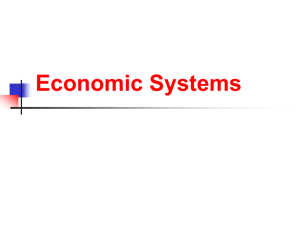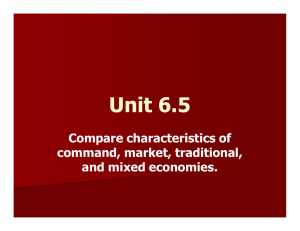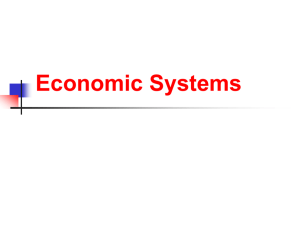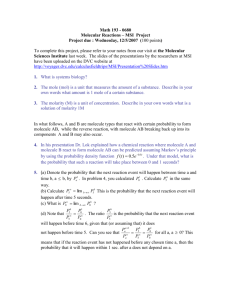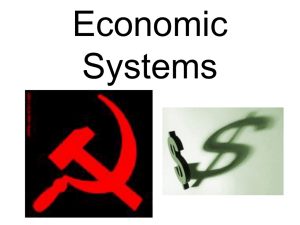Understanding Economics
advertisement
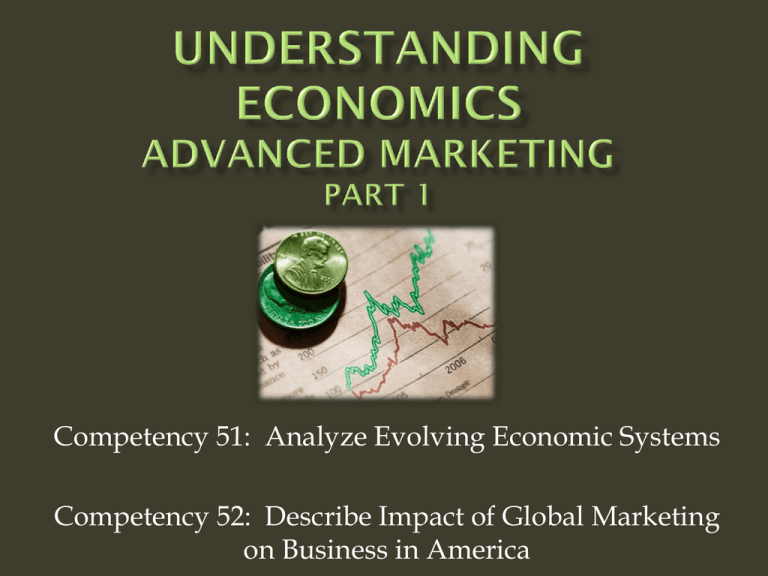
Competency 51: Analyze Evolving Economic Systems Competency 52: Describe Impact of Global Marketing on Business in America Knowledge Required to Conduct Analysis: Understanding of the types of economic systems Advantages and disadvantages of each type Understand definition of global marketing Understand impact of economic interdependence among nations resulting from evolving economies What to produce? How to produce? For Whom to produce? Land- natural resources Labor- available work force; Capital- money, Entrepreneurship-creativity; education level (skilled/unskilled) infrastructure, equipment/production facilities inventiveness Market Economy Mixed Economy Command Economy Custom-based Economy Economic systems are developed by each nation based on resources of the country and how the nation wants to answer three basic questions in how to use those limited resources The market (consumers and businesses) answers the three basic economic questions: What will be Produced- through purchases in marketplace How products will be Produced- businesses decide this; competition spurs businesses to be efficient and produce to be price competitive For Whom to produce- produce for whoever has money to purchase In a Pure Market Economy There is No Government Intervention Government answers the basic economic questions: What will be Produced- one person; dictator of group of government officials based on what they believe is important How products produced- government owns all property and therefor controls how goods and services produced For Whom to produce- government decides this; in principle wealth is shared equally to meet basic needs The individual/companies have no input Traditions and rituals answer the three basic economic questions: What will be Produced- based on the traditions- no choice in what to produce Ex: farming community that has farmed for generations How products produced- bound by tradition- uses practices from generations For Whom to produce- Tradition regulates who buys and sells and where and how exchange takes place Cultural and religious practices passed down from one generation to another is basis for decisions No economy is purely traditional, market, or command Every economy has influences that make it somewhat mixed Meaningful classification of economic systems is made based on how much a government interferes with free market Three political philosophies shape world economies: Capitalism, Socialism, and Communism Marketplace competition Private ownership of business Embraces principles of free enterprise (Private ownership, Risk, Profit, and Competition) Government is concerned about people and cares for those who cannot care for themselves Number of social services does not match that of a socialist country Government controls factors of production No private ownership of property or capital Theory is that goods owned in common (by government representing the community as a whole) are available to all as needed and that society is classless Originally referred to a system on its way to the communist ideal of a classless society Most socialist countries today have democratic political institutions Differ in capitalist nations in the increased amount of government involvement in the economy Main goal is to meet basic needs for all and to provide employment for many Characteristics include: more social services for everyone; free or low cost medical care; high taxes for business and individuals to pay for this. Government runs key industries Used interchangeably with terms capitalism and market economy Type of system in United States Four characteristics: Private Ownership of Property & Business Risk Profit Competition Divide in to groups of 2-3 people per group Using the Internet, conduct basic research and complete the Comparing Types of Economies assignment. Each member of the group must turn in this assignment separately, however, students will share laptops and collaborate in completing the activity. Due end of class. 50 Points Comparing Types of Economies Economy Market Economy Command Economy Mixed Economy Traditional Economy Factors of Production 3 Economic Questions Quiz Next Class- 50 Points Socialism Communism Capitalism Free Enterprise Characteristics of Free Enterprise Changing from centrally planned (government) economy to market economy Undergo economic liberalization (market forces set prices rather than government) Socialist countries moving towards privatization with selling off of state-run businesses to help balance their budgets Developing countries that are mostly poor with little industrialization trying to become more prosperous and develop infrastructure and improve education levels of their work force Marketing on world-wide scale Exporting Franchising Provide valuable products, solutions and services to customers locally, nationally, internationally and worldwide Benefits and Challenges of Global Marketing Impact of Increasing Competition on American businesses Resources of U.S. versus those of our foreign competitors BENEFITS Larger marketspotential for more markets Lower costs for production and distribution New supplier/vendor relationships Brand prestige CHALLENGES Different strategies for cultural, religious, and language barriers Increased expenses Loss of domestic production/jobs Risks Compete with low cost producers (foreign production) Mass market retailers (Walmart, Sears, Target, Costco, Best Buy) ability for volume purchases of low cost foreign products- results in American businesses going out of business Pricing and Distribution create more difficult environments in which to compete (Internet) Resources of US Abundance of natural resources- land mass and coastlines for shipping Entrepreneurship and Labor Diversity Skilled Labor Foreign Resources Only Canada and Australia has similar resource Low cost producers often have unskilled labor


